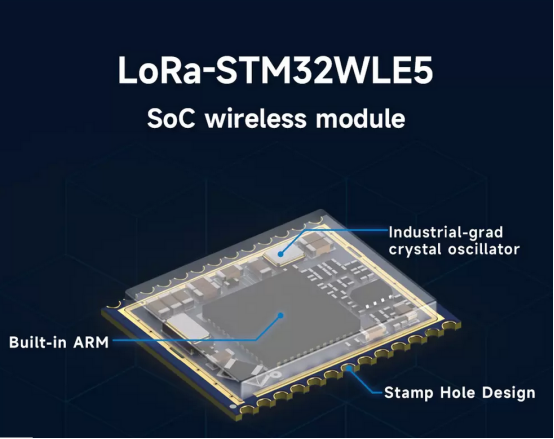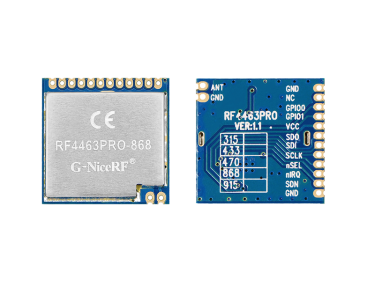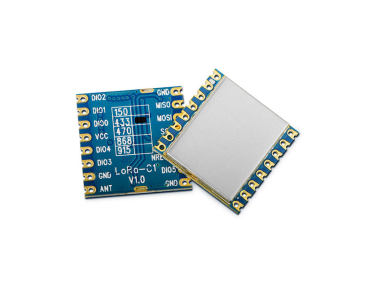Compact Design, Powerful Features: Exploring the Versatile Functions of SoC Modules
The LoRa-STM32WLE5 module is based on ST's STM32WLE5 chip and uses LoRa® modulation, making it suitable for ultra-long-range and ultra-low-power wireless solutions. It features a high-performance Arm® Cortex®-M4 core with a frequency of up to 48 MHz, supporting 256 KB of flash memory and 64 KB of RAM, along with enhanced security features. This module is widely used in security systems, smart agriculture, industrial manufacturing, and smart homes.
LoRa-STM32WLE5 Module Key Features
UHF frequency band: 433/470MHz, 868/915MHz,
Customized frequency range:150~ 960 MHz
Open area transmission distance exceeds 5000 meters
Receiving sensitivity up to -141dBm @ BW=125KHz, SF=12
Rich interface types: UART, SPI, I2C, GPIO, ADC
Sleep current less than 2µA, receive current less than 10mA
LoRa-STM32WLE5 Core Features
32-bit ARM Cortex-M4 CPU
Adaptive Real-Time Accelerator (ART Accelerator) allows execution from flash with zero wait state, frequency up to 48MHz, supports MPU and DSP instructions
Security and Protection
Hardware encryption: AES 256-bit hardware encryption (customizable)
Sector protection to prevent read/write operations (PCROP, RDP, WRP)
CRC computation unit
Unique device identifier (64-bit UID compliant with IEEE 802-2001 standard)
96-bit unique chip identifier
Hardware public key accelerator (PKA)
Introduction to SoC Module Concepts
SoC (System on Chip) modules integrate multiple functions, including processors, memory, input/output interfaces, communication modules, and graphics processors, onto a single chip. By achieving complete system functionality within a single chip, SoCs reduce size and power consumption while enhancing performance and efficiency.
Features of SoC Module
Component Integration: SoC design integrates key components such as the central processing unit (CPU), memory (RAM and ROM), input/output interfaces (e.g., GPIO, UART, USB), graphics processing unit (GPU), and accelerators onto one chip. This high level of integration reduces physical distances between modules and signal transmission time, improving system performance and response speed, while also lowering costs.
Compact Design: By integrating multiple functional modules onto a single chip, SoCs significantly reduce the physical space required for devices, making them especially suitable for applications with strict size requirements, such as smartphones, wearables, and IoT terminals.
Power Efficiency: SoCs achieve exceptional power efficiency by optimizing internal connections and reducing data movement, resulting in lower energy consumption compared to traditional multi-chip systems.
Optimized Performance: SoCs enhance overall performance through efficient inter-component communication and optimized internal architecture. Data flows more quickly between functional modules, reducing communication latency, making them particularly suitable for complex computational tasks like image processing and real-time data analysis.
Low Latency Response: The design of SoCs minimizes data transmission distances, reducing delays between components and improving overall system response speed.
Simplified Interconnect Complexity: Integrating components into one chip simplifies the interconnect structure, reducing the complexity of designing and managing communication paths.
Multicore Processing Capability: SoCs can integrate multiple processing cores, supporting efficient parallel processing and multitasking capabilities, which enhances performance and user experience.
Heterogeneous Computing: SoCs can integrate various processing units, such as CPUs, GPUs, DSPs, and dedicated accelerators, to optimize performance for different workloads. This flexible architecture allows for the dynamic selection of the most suitable processing unit based on specific tasks, improving overall system efficiency and response speed.

Advantages of SoC Modules
Miniaturization and Multi-function Integration: SoCs integrate various functions into a small chip, achieving a highly compact device design. This integration not only saves space but also reduces the need for connections between multiple components, simplifying the overall structure and layout of devices, making smaller and lighter devices possible.
Low Power Characteristics: By optimizing component connections, SoC achieve lower power consumption compared to traditional multi-chip systems. This design reduces energy loss and enhances device battery life.
Single Chip Construction: With all functions integrated onto a single chip, data transmission delays and energy consumption between different chips are minimized. This design enhances system efficiency, ensuring faster response times and lower energy consumption.
Ease of Development and Integration of SoC Modules
SoC modules are typically equipped with a wealth of development tools and support libraries, allowing developers to quickly get started. The modular design enables developers to select and configure the necessary functions based on specific application scenarios, further enhancing system flexibility.
Flexible Application Scenarios for SoC Modules
Due to their high integration and miniaturization features, SoC modules are suitable for multiple fields. For instance, in smart homes, they can enable remote control and monitoring of smart devices; in industrial automation, SoC modules can facilitate efficient data collection and real-time processing, improving production efficiency and safety.
 +86-755-23080616
+86-755-23080616
 sales@nicerf.com
sales@nicerf.com
Website: https://www.nicerf.com/
Address: 309-314, 3/F, Bldg A, Hongdu business building, Zone 43, Baoan Dist, Shenzhen, China





